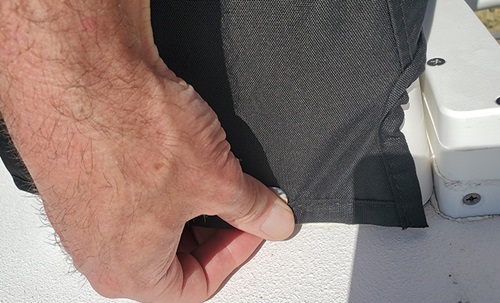Advertisement
Here’s a look at often-ignored items that need a little love

Since this hatch is on a fishbox, you can betthat strut will be exposed to plenty of grime and goo. Photo: Lenny Rudow
A well-maintained boat is a happy boat. Most of us who’ve been on the water for more than a few years pay strict attention to our maintenance routines. But boats have lots of parts, and they’re constantly exposed to the elements, doused with water, or fried by the sun. Miss the maintenance on a moving part and there’s a good chance that, sooner or later, it will cease moving altogether. Here are five commonly ignored items that should be on your list of maintenance chores.
1. Gas-assist struts
The struts that make it so easy to raise and lower your deck hatches are often advertised as “maintenance-free.” And it’s true that the gas-filled piston isn’t meant to be disassembled or even repaired; it’s generally accepted that they have a limited service life and will need to be replaced when worn out. However, you can extend that service life significantly with one simple maintenance practice: Keep them clean. Give the strut a wipe with a clean cloth to minimize grit and grime, and rinse the entire unit with freshwater every now and again, especially if it’s been exposed to saltwater. Note that this is particularly important for hatches or compartment lids that may be kept open (thus leaving the strut exposed to salt spray) and for deck hatches closing over compartments like the bilge or a fishbox, which tend to get quite dirty.
2. Screws
Have you ever found a screw rolling around on deck and wondered where the heck it came from? At least once or twice a season, grab a screwdriver, put it on every screw you can find, and tighten up all that are loose. One big repeat offender you’ll likely encounter: the small screws located on the underside of hatch latches. These ride through the seas upside-down at all times, so gravity and vibrations are always working against them. If you’ve ever had one of these latches come apart in your hands, you know why – and how to prevent it from happening in the future.

Go all through your boat and put a screwdriver on every head you can find to make sure those fittings are tight. Photo: Lenny Rudow
3. Snaps
One would think that a simple snap could be ignored, right? Well, maybe. It will probably keep working, but if you struggle to get those snaps on and off, you could pull one out of the fiberglass or rip the canvas it’s attached to. Annual maintenance will be a help. Snaps are a lot more cooperative when lubricated, making that struggle, well, a snap. There are plenty of dedicated snap lubricants on the market, but any standard-issue silicone or Teflon lube will do the trick. Dabbing on a bit of wax as you wax your boat works fine, too.
4. Steering and tilt mechanisms
If your boat has one or more outboards, chances are the engines turn in a swivel bearing (also called a swivel bracket) and/or through a steering bracket. These may be the least well-maintained parts of the average outboard owner’s power system because many boaters never even realize that there are Zerk fittings back there (see arrow in photo above) – and you need to hit them with grease. Just how often they need attention will vary with the recommendations of different manufacturers, so break out your owner’s manual and look up the maintenance schedule. And note that this should be considered a critical practice. If the bearing or bracket fails, it’s catastrophic because you can’t turn the motor anymore. And replacing it usually requires pulling the motor off the boat, so it can be a very expensive procedure. With older rigs, it can be so costly that a repower job is the ultimate result of a swivel bearing gone bad.

Find those hidden zerks, and hit ’em with grease. Photo: Lenny Rudow

Give those snaps some lubricant from time to time, and they’ll be far more cooperative. Photo: Lenny Rudow
Tip
5. Zippers
Ever wonder why your boat’s zippers are so darn tough to use? Well, when’s the last time you lubricated them? Like snaps, misbehaving zippers are something we all tend to deal with via an application of force – which can lead to damage – rather than giving them some love and care. You can get zipper lubricant and some of the snap lubes out there are dual-purpose, marketed as “snap and zipper lubricant.” Or you can use an old seafarer’s trick and simply rub a wax candle up and down the zipper.
